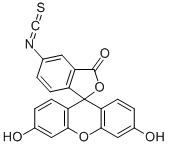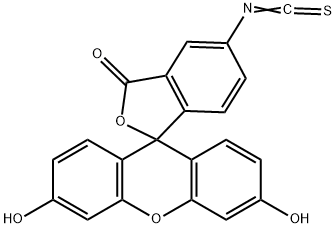Phenyl isothiocyanate , 99%, protein sequencing level , 103-72-0
Synonym(s):
Isothiocyanic acid phenyl ester, PTC;Phenyl isothiocyanate;PITC
CAS NO.:103-72-0
Empirical Formula: C7H5NS
Molecular Weight: 135.19
MDL number: MFCD00004798
EINECS: 203-138-1
PRODUCT Properties
| Melting point: | −21 °C(lit.) |
| Boiling point: | 218 °C(lit.) |
| Density | 1.132 g/mL at 20 °C(lit.) |
| vapor pressure | 10 hPa (20 °C) |
| refractive index | n |
| Flash point: | 190 °F |
| storage temp. | 2-8°C |
| solubility | water: insoluble |
| form | liquid |
| color | Clear pale yellow to yellow |
| Specific Gravity | 1.137 (20/4℃) |
| Water Solubility | Soluble in alcohol, and ether. Insoluble in water. |
| Sensitive | Moisture Sensitive |
| Merck | 14,7297 |
| BRN | 471392 |
| Dielectric constant | 10.7(20℃) |
| Stability: | Stable. Combustible. Incompatible with strong oxidizing agents, strong acids. |
| InChIKey | QKFJKGMPGYROCL-UHFFFAOYSA-N |
| LogP | 3.280 |
| Surface tension | 41.5mN/m at 20°C |
| CAS DataBase Reference | 103-72-0(CAS DataBase Reference) |
| NIST Chemistry Reference | Benzene, isothiocyanato-(103-72-0) |
| EPA Substance Registry System | Benzene, isothiocyanato- (103-72-0) |
Description and Uses
Phenyl isothiocyanate is the reagent of choice in automated Edman degradation systems. However, this reagent is highly toxic and for manual modification other reagents are preferred such as dimethy laminoazobenzene isothiocyanate (Chang, 1983; Wang et al, 2000) or trifluoroethyl isothiocyanate (Bartlet-Jones et al, 1994). This last reagent has the advantage of being volatile, so that the excess of reagent is easily removed by vacuum before MS analysis (Spengler, 1997). This compound was used successfully during seven successive cycles of manual cleavage coupled with MS analysis. Nevertheless, the high reactivity of such compounds seems to shows artefactual modification such as“acetylation' of the hydroxyl groups of the Ser and Thr. Allyl isothiocyanate shows better selectivity, but again this reagent is toxic and difficult to use in manual approaches (Gu & Preswich, 1997) .
Safety
| Symbol(GHS) |    GHS05,GHS06,GHS08 |
| Signal word | Danger |
| Hazard statements | H301-H314-H317-H334 |
| Precautionary statements | P261-P270-P280-P303+P361+P353-P304+P340+P310-P305+P351+P338 |
| Hazard Codes | T,N,Xn,F |
| Risk Statements | 25-34-42/43-51/53-67-65-50/53-36/37/38-22-11-38-63-23/24/25-36/38 |
| Safety Statements | 9-16-29-33-60-61-62-36-26-23-45-36/37/39-38-28A-36/37 |
| RIDADR | UN 1993 3/PG 2 |
| WGK Germany | 3 |
| RTECS | NX9275000 |
| F | 19 |
| TSCA | Yes |
| HS Code | 2930 90 98 |
| HazardClass | 6.1 |
| PackingGroup | II |
| Toxicity | LD50 orally in Rabbit: 157 mg/kg |




